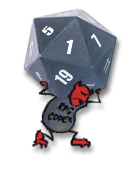I actually have to wrap this up, I gotta get ready to meet the family for lunch. I'm not sure if I am exactly answering your question, but I'll end it by saying that QA, balance passes, and design involvement every step of the way is very important in making combat feel strong and rewarding.
Well, not really, I was thinking more about the design of individual combat
encounters, but that was certainly informative.

Maybe tomorrow?
Lunch just got pushed back to 1pm, so I have a little more time.
I see. Combat Encounters.
Well, like a good DM, the designer should already have a good idea on how a fight needs to go to be both challenging and possible to win. In some games, like DnD, this becomes an exponentially difficult problem to solve with a human being involved. These encounters are all scripted, but the player's design of his character in NWN, IWD, BG, etc, is all controlled by a human.
In many cases that Human player is creating a character that might not be min maxed. In fact, that character might be chock full of role-playing goodness but be horrible in combat.
A good example of this, in the beginning of MotB, the caverns were originally filled with golems and creatures that could not be flanked or sneak attacked. If you were playing as a thief, which meant light weapons, you got WORKED. Play tests revealed this.
To solve it, we added enchanting materials very early and a new enchantment that allowed you crit and flank golems and constructs. (I might have some details fuzzy, this was a while ago).
That actually ended up NOT being enough, so we added a +3 light weapon WITH the enchantment in one of the dungeon portions of the initial starting map.
Now if that had failed, we would have had to change the creatures.
Now this is just an example, and it mainly pertains to systems where you have the freedom to create a character that is terrible, at least as far as combat is concerned. The bottom line here is being able to identify the problem. In the example above, this was easy because I played as a rogue in NWN2 OC and I got DESTROYED in MotB and I told Kevin Saunders. Jabby has a similar experience. Kevin worked on it, realized what the situation was, and came up with a solution.
Now in PnP, with a human DM, this isn't an issue. I remember when Andy Woo was running a bunch of us through Pathfinder. Josh made a cleric, Father Oswyn, who had 8 Str, 14 Wis, and 18 Int. Father Oswyn was also like 55 years old. He did this for role playing reasons and it was a lot of fun. Trying to play Father Oswyn in IWD or IWD2 would be extremely difficult.
Now in DS3, we had a pretty good idea of what all the different builds were for the 4 classes. At that point it is just adjusting damage numbers and status effect durations till it feels fair for the difficulty. Then you just repeat over and over again with each character and with different builds.
At Obsidian, we had a sharepoint page (similar to wiki) where you could put in your class and build information and how the game played, which abilities you liked, which you think were too strong or too weak. A lot of it is also listening and then explaining abilities or situations. Did you try dodging? Do you understand how blocking works? What about this, what about that? That in turn could reveal some areas that are too complicated and need to be clarified.
In the end, a lot of it comes down to time.
ps.
This was a little disjointed, I was just kind of rambling.

I'm sure the people who were (and still are) massively butthurt that Neverwinter Nights wasn't another Baldur's Gate will be thrilled to hear that.























 Then again, considering how the game turned out...
Then again, considering how the game turned out...



